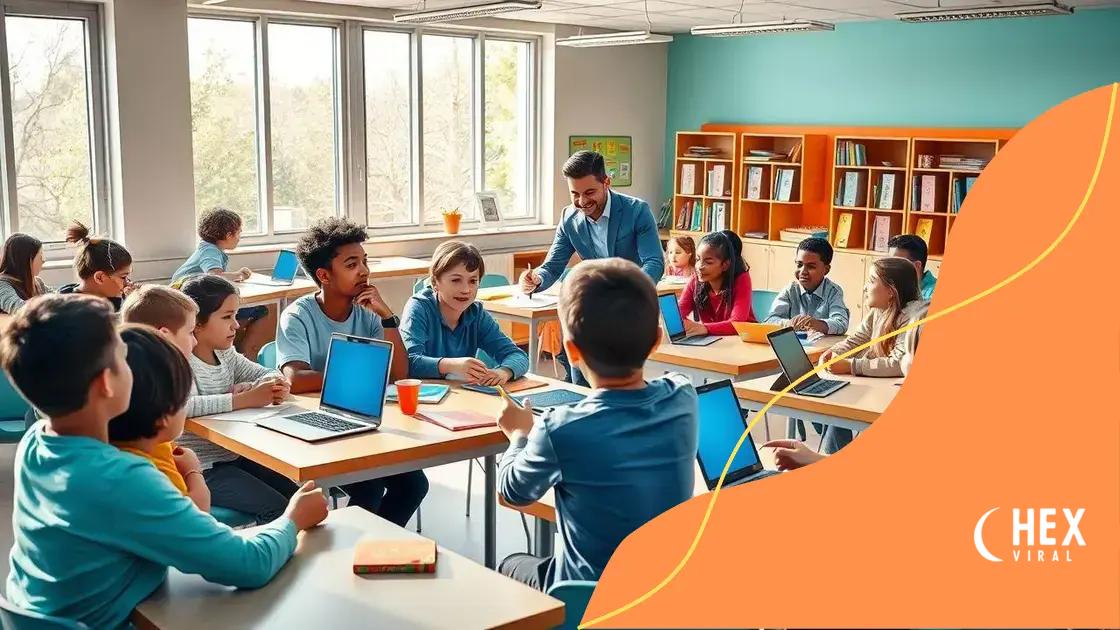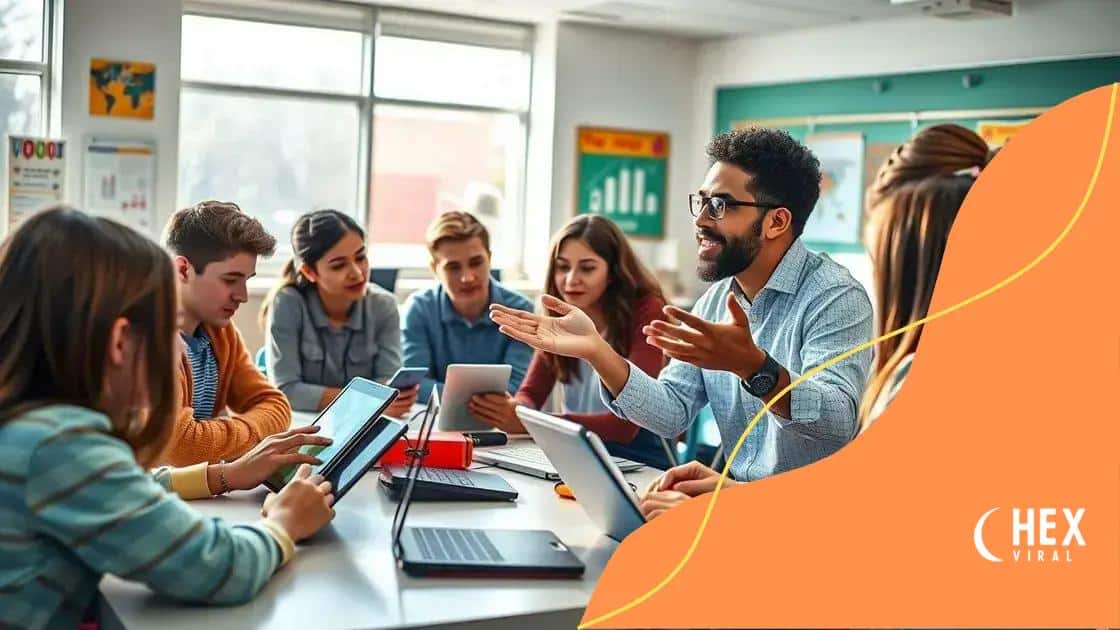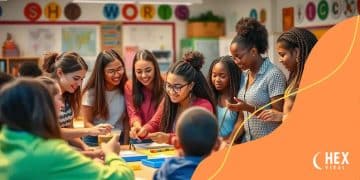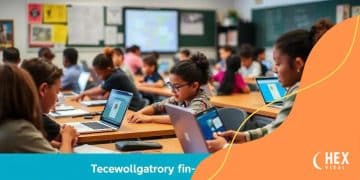Flipped classrooms: redefining homework and lectures

Flipped classrooms redefine homework and lectures by allowing students to learn new material at home and actively engage in collaborative, hands-on activities during class, enhancing understanding and retention.
Flipped classrooms are changing the way we think about traditional homework and lectures. Have you ever wondered how this innovative approach can boost student engagement and learning? Let’s dive into it.
Understanding the flipped classroom model
The flipped classroom model is an innovative educational approach that has gained popularity in recent years. Instead of the traditional method of teaching, where teachers deliver lectures in class and students do homework at home, this model flips the process. Students are introduced to new material at home, often through video lectures, and then engage in hands-on activities during class time. This allows for more interactive and personalized learning experiences.
Key Features of the Flipped Classroom
There are several essential aspects that define a successful flipped classroom environment. Teachers can utilize various resources to enhance learning and encourage student participation.
- Pre-class materials: Students review content at their own pace.
- In-class activities: Class time is dedicated to discussion and problem-solving.
- Technology integration: Use of videos and online resources fosters engagement.
In the flipped classroom model, feedback is instant. Teachers can assess understanding through interactive activities and provide direct support. This immediate response creates a more dynamic learning environment.
Benefits for Students
There are numerous advantages to implementing a flipped classroom. First, students can learn at their own pace, allowing them to focus on areas where they need more help. Second, the classroom becomes a space for collaboration, encouraging peer-to-peer learning and deeper engagement with the material. Finally, using varied resources caters to different learning styles, making education more accessible.
Overall, the flipped classroom model promotes a vibrant learning atmosphere where students are more involved in their education and actively participate in their learning process.
Benefits of flipped classrooms for students
The benefits of flipped classrooms for students are numerous and impactful. This innovative approach transforms the learning experience by allowing students to engage with materials before attending class. This method shapes a more interactive and collaborative learning environment.
Enhanced Learning Experience
One major advantage of flipped classrooms is the way they enhance the learning experience. By allowing students to review content at home, they come to class prepared. This preparatory work leads to deeper discussions and a better understanding of the material. Students feel more confident as they can ask questions about topics they find challenging.
- Students learn at their own pace, leading to greater comprehension.
- Class time is more focused on interaction and discussion.
- Immediate feedback helps students understand concepts quickly.
In a typical classroom setting, teachers often struggle to give each student individual attention during lectures. However, in a flipped classroom, the focus shifts to activities that require collaboration. As a result, students work together, solving problems and applying their knowledge actively. This method encourages teamwork and improves social skills.
Increased Student Engagement
Flipped classrooms also boost student engagement. When students are involved in hands-on activities, they retain information better. Participation is vital. Engaged students are less likely to disengage and drop out. As learners take charge of their education, they become more motivated and responsible.
Moreover, the variety of materials available for home study caters to different learning styles. Whether through videos, podcasts, or articles, students can choose what works best for them. This flexibility is a powerful motivator, as students feel empowered in their learning journeys.
How to implement flipped classrooms effectively

Implementing flipped classrooms effectively requires careful planning and consideration. Educators who want to make this shift must understand how to create an engaging and supportive learning environment. It starts with providing students with clear resources and guidance.
Choose the Right Technology
The first step in a successful flipped classroom is selecting the right technology. Teachers can use various platforms to share video lectures or reading materials. Utilizing tools like learning management systems makes it easy for students to access necessary content.
- Use video hosting sites to upload lectures.
- Choose educational software that supports interactive content.
- Ensure that students have access to the technology needed.
Once the technology is in place, it’s essential to prepare students for this new method of learning. Teachers should explain the concept of the flipped classroom and how it differs from traditional teaching. Clear communication is key! Setting expectations helps students understand their roles in this new learning format.
Create Engaging Materials
Next, creating engaging materials is critical for success. Teachers should develop content that sparks curiosity and promotes comprehension. Video lessons should be short and focused, with interactive elements included when possible.
During class, activities should encourage collaboration and problem-solving. Group discussions and hands-on projects help solidify the understanding of concepts learned at home. Active participation keeps students interested and engaged.
Regularly gathering feedback is another crucial part of the process. Teachers can ask students what works for them and what areas need improvement. This feedback helps refine the approach and creates a responsive learning environment.
Challenges educators face with the flipped model
Implementing the flipped classroom model presents several challenges for educators. Understanding these obstacles can help teachers prepare effectively. One significant issue is ensuring that all students have access to the necessary technology and resources.
Technology Access
Many students may not have reliable internet access or devices at home. This situation hinders their ability to engage with online materials before class. Therefore, teachers must find creative solutions, such as providing devices or planning for alternatives in class.
- Identify students who lack resources.
- Offer school-based solutions, like technology lending programs.
- Plan activities for those without access, ensuring no one is left behind.
Another challenge is student accountability. In traditional classrooms, attendance directly influences grades. However, in a flipped classroom, if students do not complete pre-class assignments, they can struggle during in-class discussions. Educators need to implement strategies for holding students accountable for their learning.
Creating Engaging Content
Creating engaging and effective online content is also crucial. Not all videos or materials are created equal. Teachers must avoid overwhelming students with lengthy videos that could lead to disengagement. Keeping content concise and interactive is essential.
Moreover, professional development can be a hurdle. Teachers often feel unprepared to transition to a flipped learning model. Providing training and support is vital to help educators feel confident in using new technologies and teaching strategies.
Finally, adapting assessment methods can be challenging. Traditional tests may not accurately measure students’ understanding in a flipped classroom. Educators may need to explore different assessment methods to evaluate student learning effectively.
Real-life examples of flipped classrooms in action
Real-life examples of flipped classrooms showcase how this model can transform the educational experience. Many schools around the world have successfully implemented the flipped classroom approach, resulting in increased student engagement and better learning outcomes.
Case Study: High School Science
In a high school science class, the teacher assigns short video lectures as homework. Students watch these videos at their own pace before class. During class, they engage in hands-on experiments and collaborative projects. This method allows them to apply what they’ve learned and receive immediate feedback, enhancing their understanding of complex concepts.
- Students participate in group discussions about the material.
- Hands-on activities strengthen their grasp of scientific principles.
- Immediate feedback is provided by the teacher during experiments.
This approach has shown remarkable results, with students reporting higher interest levels and improved test scores.
Case Study: University Level Math
At the university level, a math professor uses a flipped model for his calculus course. He delivers lectures via recorded videos and assigns practice problems for students to complete before class. In class, they work on solving complex problems in small groups.
This strategy encourages collaboration among students and deepens their understanding. The professor circulates among the groups to offer support and guidance. By actively solving problems together, students build confidence and improve their skills.
Benefits Observed
Both of these examples highlight key benefits of the flipped classroom model. Students are more engaged and take ownership of their learning. They enjoy the interactive nature of the classroom and appreciate the immediate support from their teachers. These real-life implementations demonstrate the potential of flipping classrooms to elevate educational experiences.
FAQ – Frequently Asked Questions about Flipped Classrooms
What is a flipped classroom?
A flipped classroom is an educational approach where students learn new content at home and engage in hands-on activities in class.
What are the main benefits of flipped classrooms for students?
The main benefits include increased student engagement, personalized learning, and immediate feedback from teachers during in-class activities.
How do I implement a flipped classroom model?
To implement a flipped classroom, choose the right technology for sharing materials, create engaging video lectures, and design interactive activities for classroom time.
What challenges do educators face with flipped classrooms?
Challenges include ensuring all students have access to technology, keeping students accountable for learning, and developing engaging content.






